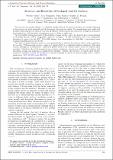Files in this item
Structure and reactivity of Cu-doped Au(111) surfaces
Item metadata
| dc.contributor.author | Grillo, Federico | |
| dc.contributor.author | Megginson, Rory | |
| dc.contributor.author | Christie, Jenny | |
| dc.contributor.author | Francis, Stephen M. | |
| dc.contributor.author | Richardson, Neville V. | |
| dc.contributor.author | Baddeley, Christopher J. | |
| dc.date.accessioned | 2018-05-21T09:30:07Z | |
| dc.date.available | 2018-05-21T09:30:07Z | |
| dc.date.issued | 2018-05-19 | |
| dc.identifier | 252850245 | |
| dc.identifier | 908f4ca4-9158-4e51-9ef4-1d9490786c92 | |
| dc.identifier | 85047353687 | |
| dc.identifier | 000434345200001 | |
| dc.identifier.citation | Grillo , F , Megginson , R , Christie , J , Francis , S M , Richardson , N V & Baddeley , C J 2018 , ' Structure and reactivity of Cu-doped Au(111) surfaces ' , e-Journal of Surface Science and Nanotechnology , vol. 16 , pp. 163-171 . https://doi.org/10.1380/ejssnt.2018.163 | en |
| dc.identifier.other | ORCID: /0000-0001-9961-1212/work/45160473 | |
| dc.identifier.other | ORCID: /0000-0001-9750-6494/work/57330779 | |
| dc.identifier.uri | https://hdl.handle.net/10023/13408 | |
| dc.description | The Engineering and Physical Sciences Research Council (EPSRC) is acknowledged for the funding of FG (EP/M029077/1) and RM (EP/506631/1). FG also acknowledges the European Union for funding the SURMOF project under which part of this work was undertaken (contract number NMP4-CT-2006-032109). | en |
| dc.description.abstract | The structure and surface chemistry of ultrathin metallic films of one metal on another are strongly influenced by factors such as lattice mismatch and the formation of near-surface alloys. New morphologies may result in modified chemical properties which in turn open up different routes for molecular adsorption, desorption and surface functionalization, with important consequences in several fields of application. The Cu/Au(111) system has received the attention of many studies, only a few however have been performed in ultra-high vacuum (UHV), using surface sensitive techniques. In this contribution, the room temperature deposition of copper onto the (22×√3)-Au(111) surface, from submonolayer to thick film, is investigated using scanning tunnelling microscopy (STM). The onset of copper adsorption is seen to occur preferentially at alternate herringbone elbows, with a preference for hcp sites. With increasing coverage, copper-rich islands exhibit a reconstructed surface reminiscent of the clean Au(111) herringbone reconstruction. Disordered, pseudo-ordered and ordered surface layers are observed upon annealing. Models for the initial adsorption/incorporation mechanism, formation of adlayers and evolution with increasing coverage and annealing are qualitatively discussed. Further, the reactivity of copper-doped Au(111) systems is considered towards the adsorption of organic molecules of interest in nanotechnology and their catalytic applications. | |
| dc.format.extent | 483401 | |
| dc.language.iso | eng | |
| dc.relation.ispartof | e-Journal of Surface Science and Nanotechnology | en |
| dc.subject | Scanning tunneling microscopy | en |
| dc.subject | Cu | en |
| dc.subject | Au(111) | en |
| dc.subject | Surface alloy | en |
| dc.subject | QD Chemistry | en |
| dc.subject | DAS | en |
| dc.subject.lcc | QD | en |
| dc.title | Structure and reactivity of Cu-doped Au(111) surfaces | en |
| dc.type | Journal article | en |
| dc.contributor.sponsor | EPSRC | en |
| dc.contributor.sponsor | European Commission | en |
| dc.contributor.institution | University of St Andrews. School of Chemistry | en |
| dc.contributor.institution | University of St Andrews. EaSTCHEM | en |
| dc.identifier.doi | https://doi.org/10.1380/ejssnt.2018.163 | |
| dc.description.status | Peer reviewed | en |
| dc.identifier.grantnumber | EP/M029077/1 | en |
| dc.identifier.grantnumber | CONTRACT NO: 032109 | en |
This item appears in the following Collection(s)
Items in the St Andrews Research Repository are protected by copyright, with all rights reserved, unless otherwise indicated.

